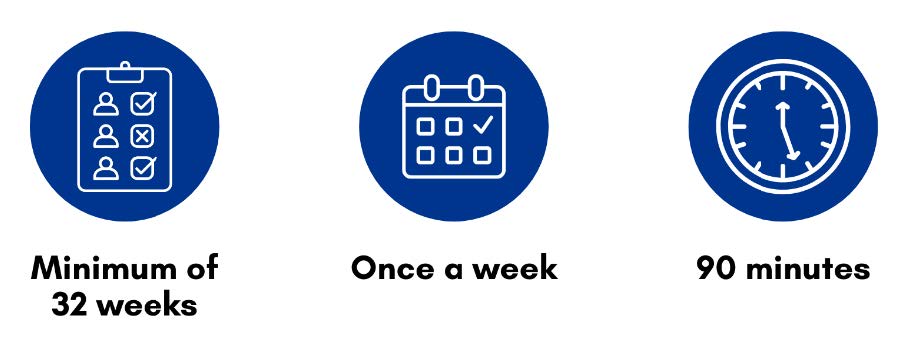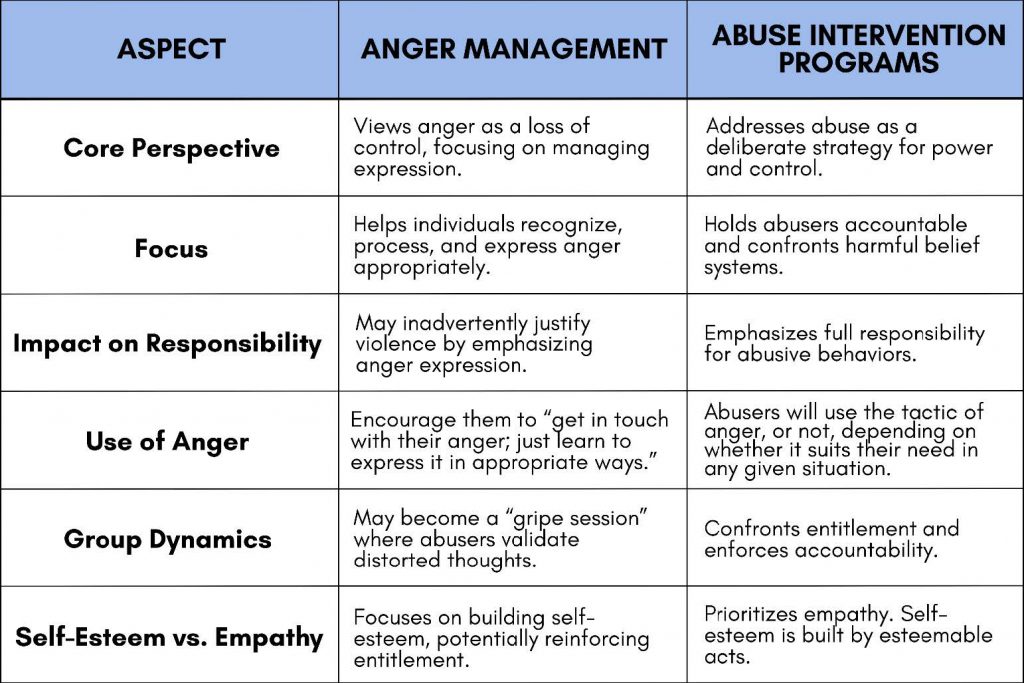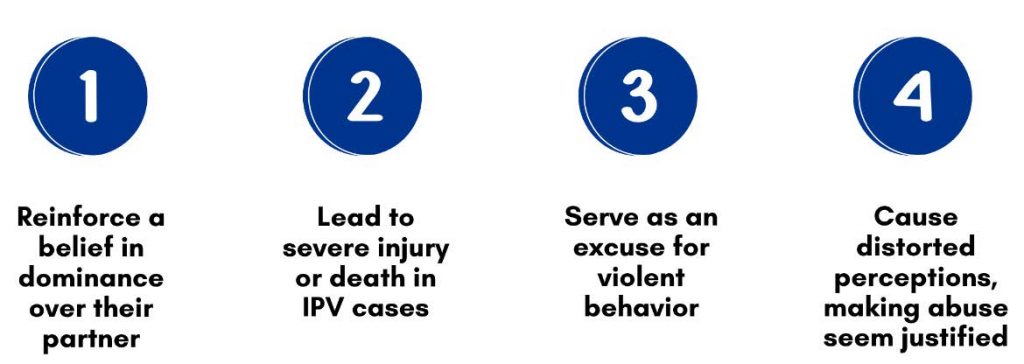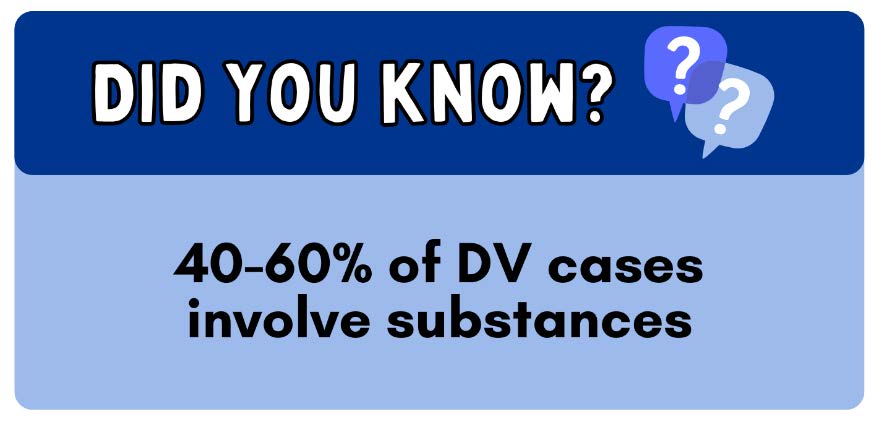Abuse Intervention Program (AIP)
The Abuse Intervention Program (AIP) sponsored by the Bergen County Department of Human Services/Division of Alternatives to Domestic Violence (BCDHS/ADV) is a highly structured program with the purpose to promote victim/survivor and victim/survivor children safety and support offender accountability. Policies, procedures and intervention curriculum should be designed to promote safety, identify risk factors, consider victim/survivor and victim/survivor children experience and consider the potential for any unintended tolerance for ongoing perpetration. Essentially, all abuse intervention programs should practice a survivor-centered approach.
Whether we call it domestic abuse, battering, conjugal terrorism, or coercive control; it is a relationship strategy where one partner in an intimate partner relationship systematically attempts to gain and maintain power and control over the victim through intimate terrorism tactics and social strategies, including manipulation, isolation, and threats. Tactics converge to entrap the survivor, generate vulnerability, and impede critical resistance.
To an abuser, real power is the ability to instill fear. Coercive Control is about creating “an environment of fear and domination that restricts the victim’s freedom and choices, effectively trapping them in a cycle of oppression.” (Stark, 2007). It works in tandem with other oppressive systems that thrive on negligence, dehumanization, erasure, and exploitation, to limit a victim/survivor and victim/survivor children’s liberty and development. This process is constantly active and encompasses a survivor’s lived reality of all individual, collective, and intergenerational disconnection from power.*
An abuser uses dominance, power and coercive control to convince their victim that they are more powerful than the system setup to protect them/her; the abuser convinces the victim that they are omnipotent. These behaviors are developed within a patriarchal social structure that overtly and covertly supports and encourages the deeply entrenched belief that he is granted certain entitlements over his partner and has the right to enforce those entitlements. It will take the overall system to confront and hold an abuser accountable.
It is with this understanding that intervention programs are not, nor should they ever presume to function as a form of psychotherapy or treatment. Therapy or treatment implies a psychological condition is the cause of the abusive behavior, obfuscating the known cause. Rather, AIPs are built on the belief that abusive behavior is volitional and instrumental in nature. Individuals who use violence, abuse and coercive control are capable of change, both in their actions and their beliefs.
The choice to use non-aggressive, non-controlling behaviors or not will always be on the individual. AIP’s have the obligation of working within a comprehensive coordinated community response to domestic violence; reporting on compliance or non-compliance within the program, violations and/or re-offenses that are disclosed to the program and providing behavioral observations to all legal mandates and involved systems.
According to the research of Edward Gondolf, in order for an abuse intervention program to achieve maximum effectiveness:
- There is on-going risk management,
- Clear consistent behavioral messages are communicated; consequences for violating intervention/treatment contracts, legal mandates, and restraining orders are upheld by all systems involved,
- Engagement in the intervention program occurs as close to the index assault as possible. The longer the individual delays involvement the less impact the intervention will have,
- The curriculum follows a survivor-based, cognitive-behavioral, psychoeducational approach, and
- Substance abuse concerns are assessed and addressed.
Therefore, it is essential for any abuse intervention program to work in collaboration with the legal system and/or mandating entities, community resources, necessary healthcare providers and survivor services. When we recognize abuse as a relationship strategy wherein one partner use dominance, power and control over the other partner, we see “the outcome creates a hostage-like condition of entrapment that arises from the suppression of a victim’s autonomy, rights and liberties through coercive control. Assessments based on coercive control identify the victim’s vulnerability to serious injury or psychological trauma as a function her objective or structural subordination rather than of the level of physical violence.” Further, with an understanding of coercive control we understand that it is adaptable and often only the abuser and the victim are aware of the threats being made and understand the severity of the threat being made. We need to be aware of the normalness of the messaging. As we broaden and deepen our understanding of power and control to extend past physical assault and injury, to that of a pattern or course of conduct, we, the system, can better empathize and understand the victim’s everlasting dilemma.
Program Focus
EXAMINE BELIEF SYSTEMS AND BEHAVIORS
Look critically at the ideas and actions that sustain violence and control.
EXPAND DEFINITIONS AND LANGUAGE
Broaden the participant’s understanding of violence and controlling behaviors.
UNDERSTAND THE IMPACT
Discuss how the participant’s violence affects current and former intimate partners, children, and even the perpetrator themselves.
IDENTIFY AND PRACTICE ALTERNATIVES
Learn non-controlling, respectful approaches that build a foundation of equity, respect, accountability, and equality.
Key Program Features and Overview

Our program length is a minimum of thirty-two (32) weeks, and it consists of group sessions that meet once a week for ninety (90) minutes. A group modality is strongly preferred; individual sessions can be contraindicated and should only be conducted in extreme cases such as severe medical conditions that prevent a participant from attending a group setting. Couples counseling or any form of conjoint family therapy is strictly prohibited as it is contraindicated and compromises victim safety.
Achieving Maximum Effectiveness in AIP
- Collaborative Risk Management – Constant support via coordinated efforts among legal systems, community resources, healthcare providers, and survivor services.
- Consistent Behavioral Messaging – Clear expectations and consequences ensure accountability from the start.
- Timely Engagement – Early intervention—ideally right after the index assault.
- Survivor-Based Curriculum – Utilize empathetic understanding and partner perspectives when addressing cognitive distortions.
- Integrated Substance Abuse – Addressing substance abuse as a risk factor for re-offense.
- Addressing Distorted Beliefs – our psychoeducational curriculum and group format addresses core beliefs that fuel control and abuse, providing a powerful foundation for new, non-violent and respectful behaviors.
- Expert-Led Facilitation – Sessions are led by experienced co-facilitators with extensive expertise in domestic violence.
- Inclusive Approach – facilitators represent diverse gender identities, fostering a well-rounded, supportive environment.
Anger Management vs. Abuse Intervention Programs
Domestic abuse is an issue of dominance, power and control. Anger Management programs put the nexus of the abuse on the perpetrator’s anger. Anger management programs obfuscate the issue of offender responsibility by focusing on the expression of anger, rather than the instrumental nature of violence and abuse. Treating abusers without theoretical grounding is dangerous and compromises the safety of victims.

Correlation Between Substance Abuse and Domestic Violence
Substance abuse will not cause a non-abusive person to use abuse towards their intimate partner. Substance use does not cause domestic abuse, but it can increase the severity of violent incidents. Studies indicate that a quarter to half of men who commit domestic violence also struggle with substance use disorders. On heavy substance use days, an abuser is 11 times more likely to use physical violence. More than 20% of men reported using substances before their most severe violent acts.
An abuser’s substance use can:

Research shows that women with partners who drink heavily are five times more likely to experience intimate partner violence (IPV). Substance use precedes 47% of domestic assaults, with 92% of male perpetrators having used substances on the day of the assault.

Coordinated Community Response:
The importance of a Coordinated Community Response for an Abuse Intervention Program:
- Research shows that when AIP’s are integrated into the coordinated community response (CCR) recidivism reduces and victim safety improves. Therefore, an Abuse Intervention Program that functions independently of a CCR compromises the integrity of the work to develop offender accountability and compromises victim safety.
- Evidence-based research shows that when an individual is actively engaged in an abuse intervention program and there are ongoing risk assessments that are communicated within a systematic coordinated community response, the risk of lethality and serious harm towards a victim is reduced significantly.
- The AIP receives a participant’s mandate from the Court or a referral from child protection (DCPP), and other agencies.
- AIP’s provide ongoing feedback regarding participant; attendance, level of participation, and risk factors.
- This ongoing communication ensures that the judge’s orders are enforced and that violations can be consistently and swiftly addressed.
Reference:
DCF Abuse Intervention Program Overview. (2025). Nj.gov. https://www.nj.gov/dcf/women/abuse-intervention/
Non-Violence Program:
Overview
The Non-Violence Program (NVP) differs from the Abuse Intervention Program in modality and approach. The Nonviolence Program was created to differentiate coercive control from resistive force to provide appropriate intervention for this population. The Nonviolence Program utilizes a trauma-informed, survivor-center approach to psychoeducation, narrative therapy, and cognitive behavioral therapeutic techniques to increase awareness of coercive control, address the impact that it has on one’s sense of self and other relationships, and promote non-aggressive reactions to external stimuli, specifically coercive control.
Key Concepts
- Coercive Control: Exploits societal power hierarchies and patriarchal oppression, leading to entrapment and suppression of autonomy.
- Resistive Force: Victims of coercive control may use violence as a method of self-protection or to reclaim dignity.
Program Structure
- Modality: Designed to differentiate coercive control from reactive aggression.
- Approach: Focuses on the complexity of reactive aggression rather than treating it as equivalent to coercive control.
Intervention Approach
Providing the same intervention for coercive control and reactive aggression is ineffective and can increase recidivism. NVP contextualizes violence without excusing it and recognizes institutional responses that may reinforce harmful dynamics.
Additional Services provided within AIP
- Family violence
- Juvenile offenses
- Intimate Partner Abuse Unrelated to Coercive Control
Referral Process:
Alternatives to Domestic Violence Abuse Intervention Program works in close communication with Bergen Superior Court, Bergen Municipal Courts, Bergen County Probation Department, NJ State Parole and the Division of Child Protection and Permanency. If you are part of any of the aforementioned entities or any other agency and would like to refer a potential participant to the Program, please provide the following:
- Alternatives to Domestic Violence Referral form
- Signed release by the potential participant
- Any relevant court orders/court documents
- Any relevant police reports
*Once a potential participant is referred to the Program they must reach out to the AIP line to enroll in the Program. The AIP line is 201-336-7525. *
For any questions regarding the referral process or to submit a referral to the Program, please email ADVMonitoring@co.bergen.nj.us or call the AIP line at 201-336-7525.
For any provider questions please feel free to reach out to:
Patrick Lovaglio, Abuse Intervention Program Supervisor- 201-336-7589
Corina Araneda, Abuse Intervention Program Monitoring Coordinator- 201-336-7582
Internship Opportunities:
For any inquiries, please feel free to reach out with resume and cover letter to:
Patrick Lovaglio, Abuse Intervention Program Supervisor – plovaglio@bergencountynj.gov
